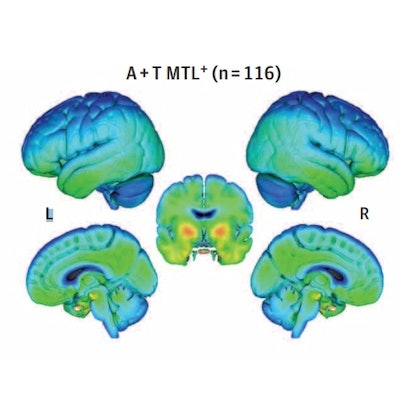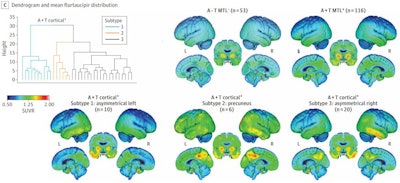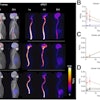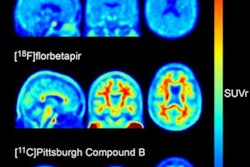
PET scans in patients with early Alzheimer's disease reveal patterns of tau deposits that could help researchers improve the selection of at-risk patients for new drug trials, according to a study published April 18 in JAMA Neurology.
A U.S. team analyzed cortical tau PET patterns seen in clinically unimpaired individuals diagnosed with early Alzheimer's disease. They found that divergent patterns of cortical tau uptake are present in approximately 9% of individuals with early Alzheimer's disease.
"Cortical tau PET patterns exist among patients with preclinical [Alzheimer's disease] and are more common than currently appreciated," wrote corresponding author Christina Young, PhD, a neuroscience postdoctoral fellow at Stanford University, and colleagues.
Patients with preclinical Alzheimer's disease are diagnosed based on imaging or blood tests for abnormal levels of beta-amyloid plaque, a known early sign. Moreover, studies have shown that the presence of amyloid plaque is associated with the misfolding and accumulation of tau proteins, which triggers cognitive decline in later stages of the disease.
Although the nature of the relationship between these two hallmarks of Alzheimer's disease remains unclear, both amyloid plaque and tau are targets for new drugs clinicians hope may halt the progression of the disease.
Further, most tau PET studies of clinically unimpaired Alzheimer's disease patients have focused on the brain's medial temporal lobes (MTLs), which postmortem exams have shown to be regions of interest (ROIs), according to the authors. It is unknown whether atypical tau patterns spread beyond these ROIs, however, and whether they can be detected in preclinical Alzheimer's disease patients.
To elucidate this issue, the researchers analyzed F-18 flortaucipir PET scans from 447 patients with early Alzheimer's disease based on abnormal beta-amyloid levels (labeled "A+" individuals in the study) who participated in four previous studies. Participants had a mean age of 71.8 years (54% women) and were clinically unimpaired when they underwent the imaging exams.
A total of 36 individuals in the A+ group (9%) showed asymmetrical cortical tau patterns or unusually high levels of cortical tau compared with 116 patients (30%) with elevated tau accumulation in MTL regions, according to the findings.
 (C) Mean F-18 flortaucipir PET distribution patterns for each study group. A- indicates normal beta-amyloid; A+ indicates elevated beta-amyloid. A-T MTL- indicates normal beta-amyloid without elevated MTL tau; A-T MTL+ indicates normal beta-amyloid and elevated MTL tau. A+T MTL- indicates preclinical Alzheimer's disease without elevated MTL tau; A+T MTL+ indicates preclinical Alzheimer's disease and elevated MTL tau. MTL = medial temporal lobe; SUVR = standardized uptake value ratio. Image courtesy of JAMA Neurology.
(C) Mean F-18 flortaucipir PET distribution patterns for each study group. A- indicates normal beta-amyloid; A+ indicates elevated beta-amyloid. A-T MTL- indicates normal beta-amyloid without elevated MTL tau; A-T MTL+ indicates normal beta-amyloid and elevated MTL tau. A+T MTL- indicates preclinical Alzheimer's disease without elevated MTL tau; A+T MTL+ indicates preclinical Alzheimer's disease and elevated MTL tau. MTL = medial temporal lobe; SUVR = standardized uptake value ratio. Image courtesy of JAMA Neurology.Individuals in the A+ group with cortical tau were younger than those in the A+ group with MTL tau, and although memory scores were comparable between the groups, executive functioning scores were lower for the A+ cortical tau group than for the A+ MTL tau group, the researchers wrote.
"This study suggests that early tau deposition may follow multiple trajectories during preclinical [Alzheimer's disease] and may involve several cortical regions," the authors stated.
Ultimately, investigations of tau PET spatial heterogeneity in patients with early Alzheimer's disease are challenging because only 20% to 30% of clinically unimpaired individuals in their 70s are positive for abnormal beta-amyloid and less than half of these individuals will have an elevated tau signal, the researchers wrote.
Nonetheless, an understanding of the earliest patterns of tau deposits in people with preclinical Alzheimer's disease has important implications for clinical trials and for understanding the factors associated with divergent tau patterns, they suggested.
"Tau PET staging procedures, especially those based on neuropathology, that assume a uniform trajectory across individuals with preclinical [Alzheimer's disease] may be insufficient for disease monitoring," Young and colleagues concluded.





















